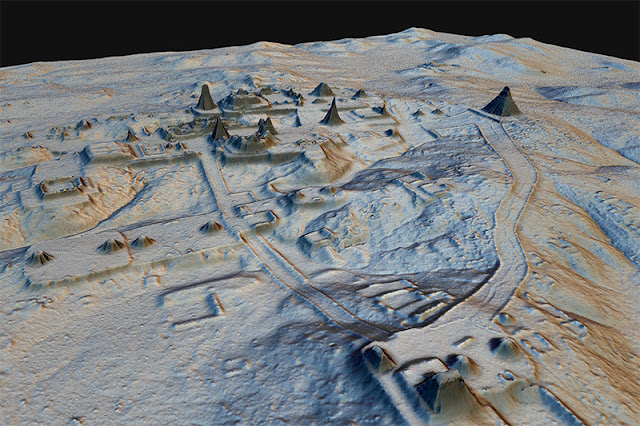Tulane University researchers, documenting the discovery of dozens of ancient cities in northern Guatemala through the use of jungle-penetrating Lidar (light detection and ranging) technology, have published their results in the prestigious journal Science.
The article includes the work of Marcello Canuto, director of the Middle American Research Institute at Tulane, and Francisco Estrada-Belli, a research assistant professor at Tulane and director of the Holmul Archaeological Project since 2000. They worked with assistant professor of anthropology Thomas Garrison of Ithaca College as well as other scholars to make their discoveries in the Petén forest of Guatemala.
 |
| The Tikal region of Guatemala, as well as a virtual view without vegetation using lidar [Credit: Francisco Estrada-Belli/PACUNAM] |
"Since LiDAR technology is able to pierce through thick forest canopy and map features on the earth's surface, it can be used to produce ground maps that enable us to identify human-made features on the ground, such as walls, roads or buildings," Canuto said.
- 61,480 ancient structures in the survey region, resulting in an estimated population of 7 to 11 million at height of the Late Classic period (650-800 CE). The structures include isolated houses, large palaces, ceremonial centers and pyramids.
- 362 square kilometers of terraces or otherwise modified agricultural terrain and another 952 square kilometers of viable farmland, demonstrating a landscape heavily modified for the intensive agriculture necessary to sustainably support massive populations for many centuries.
- 106 square kilometers of causeways within and between urban centers and numerous, sizeable defensive earthworks. This substantial infrastructure investment highlights the interconnectivity of cities and hinterlands as well as the scale of Maya warfare.
 |
| A lidar image of the Maya settlement Naachtun, where yellow dots and red patches represent buildings and causeways are marked in gray [Credit: Luke Auld-Thomas and Marcello A. Canuto/PACUNAM] |
Both Canuto and Estrada-Belli noted that discoveries were made in a matter of minutes, compared to what would have taken years of fieldwork without the LiDAR technology.
New technology makes it possible to study and visualize ancient Maya cities like never before
[Credit: Luke Auld-Thomas and Francisco Estrada-Belli/PACUNAM]
Author: Barri Bronston | Source: Tulane University [September 28, 2018]










No comments: